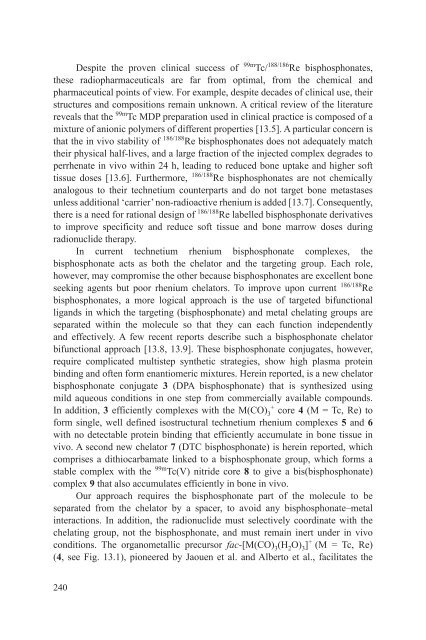Yttrium-90 and Rhenium-188 Radiopharmaceuticals for Radionuclide Therapy
Pub1662web-89688003
Pub1662web-89688003
Create successful ePaper yourself
Turn your PDF publications into a flip-book with our unique Google optimized e-Paper software.
Despite the proven clinical success of 99m Tc/ <strong>188</strong>/186 Re bisphosphonates,<br />
these radiopharmaceuticals are far from optimal, from the chemical <strong>and</strong><br />
pharmaceutical points of view. For example, despite decades of clinical use, their<br />
structures <strong>and</strong> compositions remain unknown. A critical review of the literature<br />
reveals that the 99m Tc MDP preparation used in clinical practice is composed of a<br />
mixture of anionic polymers of different properties [13.5]. A particular concern is<br />
that the in vivo stability of 186/<strong>188</strong> Re bisphosphonates does not adequately match<br />
their physical half-lives, <strong>and</strong> a large fraction of the injected complex degrades to<br />
perrhenate in vivo within 24 h, leading to reduced bone uptake <strong>and</strong> higher soft<br />
tissue doses [13.6]. Furthermore, 186/<strong>188</strong> Re bisphosphonates are not chemically<br />
analogous to their technetium counterparts <strong>and</strong> do not target bone metastases<br />
unless additional ‘carrier’ non-radioactive rhenium is added [13.7]. Consequently,<br />
there is a need <strong>for</strong> rational design of 186/<strong>188</strong> Re labelled bisphosphonate derivatives<br />
to improve specificity <strong>and</strong> reduce soft tissue <strong>and</strong> bone marrow doses during<br />
radionuclide therapy.<br />
In current technetium rhenium bisphosphonate complexes, the<br />
bisphosphonate acts as both the chelator <strong>and</strong> the targeting group. Each role,<br />
however, may compromise the other because bisphosphonates are excellent bone<br />
seeking agents but poor rhenium chelators. To improve upon current 186/<strong>188</strong> Re<br />
bisphosphonates, a more logical approach is the use of targeted bifunctional<br />
lig<strong>and</strong>s in which the targeting (bisphosphonate) <strong>and</strong> metal chelating groups are<br />
separated within the molecule so that they can each function independently<br />
<strong>and</strong> effectively. A few recent reports describe such a bisphosphonate chelator<br />
bifunctional approach [13.8, 13.9]. These bisphosphonate conjugates, however,<br />
require complicated multistep synthetic strategies, show high plasma protein<br />
binding <strong>and</strong> often <strong>for</strong>m enantiomeric mixtures. Herein reported, is a new chelator<br />
bisphosphonate conjugate 3 (DPA bisphosphonate) that is synthesized using<br />
mild aqueous conditions in one step from commercially available compounds.<br />
In addition, 3 efficiently complexes with the M(CO) 3 + core 4 (M = Tc, Re) to<br />
<strong>for</strong>m single, well defined isostructural technetium rhenium complexes 5 <strong>and</strong> 6<br />
with no detectable protein binding that efficiently accumulate in bone tissue in<br />
vivo. A second new chelator 7 (DTC bisphosphonate) is herein reported, which<br />
comprises a dithiocarbamate linked to a bisphosphonate group, which <strong>for</strong>ms a<br />
stable complex with the 99m Tc(V) nitride core 8 to give a bis(bisphosphonate)<br />
complex 9 that also accumulates efficiently in bone in vivo.<br />
Our approach requires the bisphosphonate part of the molecule to be<br />
separated from the chelator by a spacer, to avoid any bisphosphonate–metal<br />
interactions. In addition, the radionuclide must selectively coordinate with the<br />
chelating group, not the bisphosphonate, <strong>and</strong> must remain inert under in vivo<br />
conditions. The organometallic precursor fac-[M(CO) 3 (H 2 O) 3 ] + (M = Tc, Re)<br />
(4, see Fig. 13.1), pioneered by Jaouen et al. <strong>and</strong> Alberto et al., facilitates the<br />
240




